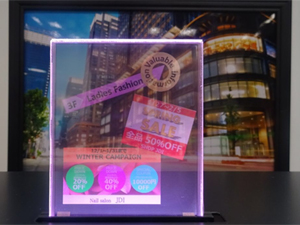



Date:17/02/17
 Japan Display Inc (JDI) developed a see-through display with a transmittance of 80%.
Japan Display Inc (JDI) developed a see-through display with a transmittance of 80%.
The display was exhibited at a technology session that JDI had Jan 25, 2017, in Tokyo. When the screen is off, it is a transparent panel. When it is turned on, an image is displayed on the screen.
JDI proposes using the display to show video on a mirror, glass plate, etc. It plans to develop applications to cars, showcases, etc by using AR (augmented reality) and MR (mixed reality) technologies.
The transmittance of the see-through display is more than 50% higher than that of JDI's previous see-through display. As a result, it became possible to see the background clearly. Also, with the high transmittance, when the screen is off, it seems as if the screen is inexistent, making it possible to improve the design of a product in which the display is embedded, the company said.
The high transmittance was realized mainly by employing a display structure that does not use a polarizing plate or color filter, which prevents light transmission. Though JDI currently does not disclose the kind of the display or the details of the technologies used for the display, the exhibited display seemed to be an LCD display.
The transmittance of JDI's previous see-through LCD displays using a polarizing plate or color filter was 10-30%, the company said. In the case of JDI's see-through OLED display, it is possible to display an image without using a polarizing plate or color filter. But its transmittance is 45% because, for example, its aperture ratio is lower than that of an LCD display, according to the company.
JDI plans to announce the technologies used for the see-through display at SID, an academic conference on display technologies, in May 2017 in the US. The screen size, pixel count and resolution of the exhibited display are 4 inches, 300 x 300 and 117ppi, respectively.
JDI Develops Transparent Display Featuring An 80% Transmittance
 Japan Display Inc (JDI) developed a see-through display with a transmittance of 80%.
Japan Display Inc (JDI) developed a see-through display with a transmittance of 80%.The display was exhibited at a technology session that JDI had Jan 25, 2017, in Tokyo. When the screen is off, it is a transparent panel. When it is turned on, an image is displayed on the screen.
JDI proposes using the display to show video on a mirror, glass plate, etc. It plans to develop applications to cars, showcases, etc by using AR (augmented reality) and MR (mixed reality) technologies.
The transmittance of the see-through display is more than 50% higher than that of JDI's previous see-through display. As a result, it became possible to see the background clearly. Also, with the high transmittance, when the screen is off, it seems as if the screen is inexistent, making it possible to improve the design of a product in which the display is embedded, the company said.
The high transmittance was realized mainly by employing a display structure that does not use a polarizing plate or color filter, which prevents light transmission. Though JDI currently does not disclose the kind of the display or the details of the technologies used for the display, the exhibited display seemed to be an LCD display.
The transmittance of JDI's previous see-through LCD displays using a polarizing plate or color filter was 10-30%, the company said. In the case of JDI's see-through OLED display, it is possible to display an image without using a polarizing plate or color filter. But its transmittance is 45% because, for example, its aperture ratio is lower than that of an LCD display, according to the company.
JDI plans to announce the technologies used for the see-through display at SID, an academic conference on display technologies, in May 2017 in the US. The screen size, pixel count and resolution of the exhibited display are 4 inches, 300 x 300 and 117ppi, respectively.
Views: 518
©ictnews.az. All rights reserved.Similar news
- Azerbaijani project to monitor disease via mobile phones
- Innovative educational system to be improved under presidential decree
- NTRC prolongs license of two TV and radio organizations for 6 years
- Azerbaijan establishes e-registry for medicines
- Azerbaijani museum introduces e-guide
- Nar Mobile opens “Nar Dunyasi” sales and service center in Siyazan city
- International conference on custom electronic services held in Baku
- OIC secretary general to attend COMSTECH meeting in Baku
- Azerbaijan develops earthquake warning system
- New law to regulate transition to digital broadcasting in Azerbaijan
- Azerbaijani State Social Protection Fund introduces electronic digital signature
- Intellectual traffic management system in Baku to be commissioned in December
- Tax Ministry of Azerbaijan started receiving video-addresses
- World Bank recommends Azerbaijan to speed up e-service introduction in real estate
- Azerbaijan to shift to electronic registration of real estate





















